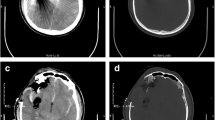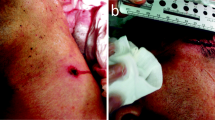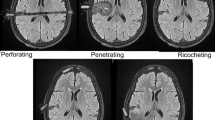Abstract
There are two distinct mechanisms of ballistic injury. Crushing of tissue resulting in a permanent tract is the primary factor in wounding of most tissues and most body regions. Temporary cavitation causes radial tissue displacement and subsequent shearing, compression and especially stretching of tissue analogous to blunt trauma. In contrast to the effect in elastic tissue, temporary cavitation can contribute substantially to wounding of inelastic tissue, such as the brain. This is the case in penetrating gunshot wounds to the head. Additionally, the penetration of the bony cranium can produce secondary missiles in the form of bone or bullet fragments and a tendency of the bullet to deformation and early yaw. Most important, wounding resulting from temporary cavitation is greatly augmented by the confined space provided by the unyielding walls of the skull. Bone contact and enhanced effects of temporary cavitation result in an enlarged zone of disintegrated tissue and in high intracranial peak pressures. Morphological signs of powerful intracranial pressure effects are cortical contusion zones, indirect skull fractures and perivascular haemorrhages remote from the tract. Depending on ballistic and anatomical parameters, the intracranial effect varies from slightly more severe injury than in isolated soft tissue to an “explosive” type of injury with comminuted fractures of the skull and laceration of the brain. Incapacitation is the physiologically based inability to perform complex and longer lasting movements independent of consciousness or intention. Immediate incapacitation is possible following craniocerebral gunshot wounds or wounds that disrupt the upper cervical spinal cord only. Rapid incapacitation can be produced by massive bleeding from major vessels or the heart. Immediate incapacitation is the result of primary intracranial effects of the bullet. A mechanism similar to commotio cerebri applied extracranially does not exist in cases of penetrating gunshot wounds to the head.
Similar content being viewed by others
References
Allen IV, Scott R, Tanner JA (1982) Experimental high-velocity missile head injury. Injury 14:183–193
Allen IV, Kirk J, Maynard RL, Cooper GK, Scott R, Crockard A (1983) Experimental penetrating head injury: some aspects of light microscopical and ultrastructural abnormalities. Acta Neurochir Suppl (Wien) 32:99–104
Barnett JC, Meirowsky AM (1955) Intracranial hematomas associated with penetrating wound of the brain. J Neurosurg 12:34–38
Berg S (1964) Die Durchschlagskraft von Pistolengeschossen im menschlichen Körper. Arch Kriminol 134:17–23
Beyer JC (ed) (1962) Wound ballistics. Office of the Surgeon General, Department of the Army, Washington DC, p 135
Black AN, Burns BD, Zuckerman S (1941) An experimental study of the wounding mechanism of high-velocity missiles. BMJ 2:872–874
Bowen TE, Bellamy RF (1988) Emergency war surgery, second United States revision of the emergency war surgery handbook. United States Department Of Defense, Washington DC, pp 1333
Butler FG, Puckett WO, Harvey EN, McMillan JH (1945) Experiments on head wounding by high velocity missiles. J Neurosurg 2:358–363
Callender GR, French RW (1935) Wound ballistics. Studies in the mechanism of wound production by rifle bullets. Mil Surg 77:177–201
Carey ME, Sarna GS, Farrel JB, Happel LT (1989) Experimental missile wound to the brain. J Neurosurg 71:754–764
Clemedson CJ, Falconer B, Frankenberg L, Jönsson A, Wennerstrand J (1973) Head injuries caused by small-calibre, high-velocity bullets. Z Rechtsmed 73:103–114
Cooper GJ, Ryan JM (1990) Interaction of penetrating missiles with tissues: some common misapprehensions and implications for wound management. Br J Surg 77:606–610
Crockard HA (1975) Early intracranial pressure studies in gunshot wounds of the brain. J Trauma 15:339–347
Crockard HA, Brown FD, Johns LM, Mullan S (1977a) An experimental cerebral missile injury model in primates. J Neurosurg 46:776–783
Crockard HA, Brown FD, Calica AB, Johns LM, Mullan S (1977b) Physiological consequences of experimental cerebral missile injury and use of data analysis to predict survival. J Neurosurg 46:784–794
Denny-Brown D, Russel WR (1941) Experimental cerebral concussion. Brain 64:93–164
DiMaio VJM (1985) Gunshot wounds. Practical aspects of firearms, ballistics and forensic techniques. Elsevier, New York Amsterdam Oxford
DiMaio VJM, Zumwalt RE (1977) Rifle wounds from high velocity, center-fire hunting ammunition. J Forensic Sci 22:132–140
DiMaio VJM, Jones JA, Caruth WW III, Anderson LL, Petty CS (1974) A comparison of the wounding effects of commercially available handgun ammunition suitable for police use. FBI Law Enforce Bull 43 (12):3–8
Dittmann W (1989) Wundballistische Untersuchungen zur Klinik der Schädel-Hirn-Schußverletzungen. Wehrmed Monatsschr 33:3–14
Dzieman AJ, Mendelson JA, Lindsey D (1961) Comparison of the wounding characteristics of some commonly encountered bullets. J Trauma 1:341–353
Fackler ML (1987) Position paper. In: Wound ballistic workshop, Quantico, September 15–17, 1987: 9 mm vs .45 auto, FBI Academy Firearms Training Unit, pp 8–17
Fackler ML (1988) Wound ballistics. A review of common misconceptions. JAMA 259:2730–2736
Fackler ML (1989) Wounding patterns of military rifle bullets. Int Defense Rev 1:59–64
Fackler ML (1991) Comment to Cat Brain Shots. Wound Ballistics Rev 1(1):41–42
Fackler ML (1992) Police handgun ammunition selection. Wound Ballistics Rev 1(3):32–37
Fackler ML, Malinowski JA (1985) The wound profile: a visual method for quantifying gunshot wound components. J Trauma 25:522–529
Fackler ML, Peters CE (1991) The “shock wave” myth (and comment). Wound Ballistics Rev 1(1):38–40
Fackler ML, Surinchak JS, Malinowski JA, Brwen RE (1984a) Bullet fragmentation: a major cause of tissue disruption. J Trauma 24:35–39
Fackler ML, Surinchak JS, Malinowski JA, Bowen RE (1984b) Wounding potential of the Russian AK-74 assault rifle. J Trauma 24:263–266
Fackler ML, Bellamy RF, Malinowski JA (1988) The wound profile: Illustration of the missile-tissue interaction. J Trauma 28(1)[Suppl]:S21-S29
Finnie JW (1993) Pathology of experimental traumatic craniocerebral missile injury. J Comp Pathol 108:93–101
Freytag E (1963) Autopsy findings in head injuries from firearms. Statistical evaluation of 254 cases. Arch Pathol (Lond) 76:215–225
Gerber AM, Moody RA (1972) Craniocerebral missile injuries in the monkey: an experimental physiological model. J Neurosurg 36:43–49
Goroncy C (1924) Handlungsfähigkeit Kopfschußverletzter. Dtsch Z Gerichtl Med 4:145–164
Harvey EN, Butler EG, McMillan JH, Puckett WO (1945) Mechanism of wounding. War Med 8:91–104
Harvey EN, Korr IM, Oster G, McMillan JH (1947) Secondary damage in wounding due to pressure changes accompanying the passage of high velocity missiles. Surgery 21:218–239
Hatcher JS (1935) Textbook of pistols and revolvers. Their ammunition, ballistics and use. Smallarms technical publications company, Marines
Henn R, Liebhardt E (1969) Zur Topik außerhalb des Schußkanals gelegener Hirnrindenblutungen. Arch Kriminol 143:188–191
Hollerman JJ, Fackler ML, Coldwell DM, Ben-Menachem Y (1990) Gunshot wounds. 1. Bullets, ballistics and mechanisms of injury. AIR 155:685–690
Hopkinson DAW, Watts JC (1963) Studies in experimental missile injuries of skeletal muscle. Proc R Soc Med 56:461–468
Illchmann-Christ A (1951) Zur Frage der Beurteilung der Handlungsfähigkeit und Lebensdauer nach stumpfen Schädeltraumen. Arch Orthop Unfallchir 44:586–605
Jason A (1991) The “twilight zone” of wound ballistics. Wound Ballistics Rev 1(1):8–9
Kaufman HH, Loyola WP, Makela ME, Frankowsky RF, Wagner KA, Bustein DP, Gildenberg PC (1986) Gunshot wounds to the head: a perspective. Neurosurgery 18:689–695
Kirkpatrick JB, DiMaio VJM (1978) Civilian gunshot wounds of the brain. J Neurosurg 48:185–198
Klages U, Weithoener D, Frössler H, Terwort H (1975) Überlebenszeit, Handlungsfähigkeit und röntgenologische Diagnostik bei Schußverletzungen des Schädels. Z Rechtsmed 76:307–319
Klaue R (1949) Die indirekten Frakturen der vorderen Schädelgrube beim Schädeldachschuß. Dtsch Z Nervenheilkd 161:167–193
Knudsen PJT, Theilade P (1993) Terminal ballistics of the 7.62 mm NATO bullet. Autopsy findings. Int J Legal Med 106:61–67
Kocher T (1895) Zur Lehre von den Schußwunden durch die Kleinkalibergeschosse. Fischer, Cassel
Kolsky H (1980) The role of stress waves in penetration processes. In: Labile RC (ed) Ballistic materials and penetration mechanics. Elsevier, New York, pp 185–223
König HG, Schmidt V (1989) Beobachtungen zur Ausbreitungsgeschwindigkeit und Entstehungsursache von Berstungsfrakturen beim Schuß. Beitr Gerichtl Med 47:247–255
Krauss M (1957) Studies in wound ballistics: temporary cavity effects in soft tissues. Mil Med 121:221–231
Krönlein RU (1899) Beitrag zur Lehre der Schädel-Hirnschüsse aus unmittelbarer Nähe mittels des schweizerischen Repetiergewehrs Modell 1889. Arch Klin Chir 59:67–76
Lampel W, Langenbach HJ (1961) Geschoßwirkung auf Wild. Wild Hund 64:41–52
Levy V, Rao VJ (1988) Survival time in gunshot and stab wound victims. Am J Forensic Med Pathol 9:215–217
Lindsey D (1980) The idolatry of velocity, or lies, damn lies, and ballistics. J Trauma 20:1068–1069
Lorenz R (1948) Der Schußkanal im Röntgenbilde. Dtsch Z Gerichtl Med 39:435–448
Meixner K (1931) Die Handlungsfähigkeit Schwerverletzter. Dtsch Z Gerichtl Med 16:139–165
Mertens (1917) Ein Beitrag zur Erklärung der Krönlein'schen Schädel-Hirnschüsse. Beitr Klin Chir 108:371–394
Metter D, Schulz E (1983) Morphologische Merkmale der Schußwunden in Leber und Milz. Z Rechtsmed 90:167–172
Naegeli O (1884) Zwei perforirende Hirnschüsse. Mord oder Selbstmord? Vjschr Gerichtl Med 40:231–264
Newgard K (1992) The physiological effects of handgun bullets. Wound Ballistics Rev 1(3):12–17
Noetzel H (1948) Über die Hirnkontusion beim einfachen äußeren Prellschuß. Nervenarzt 19:12–21
Oehmichen M, König HG, Staak M (1985) Morphologie des Hirnschusses. Beitr Gerichtl Med 43:55–61
Pankratz H, Fischer H (1985) Zur Wundballistik des KrönleinSchusses. Z Rechtsmed 95:213–215
Payr E (1922) Der frische Schädelschuß. In: Schjerning O von (ed) Handbuch der ärztlichen Erfahrungen im Weltkrieg 1914/1918, vol 1. Barth, Leipzig, pp 285–410
Peng L, Cheng Z, Guangji Z, Yinqiou L, Reifeng G (1990) An experimental study of craniocerebral injury caused by 7.62 mm bullets in dogs. J Trauma (China) Suppl 6(2):187–191
Petersohn F (1967) Über die Aktions- und Handlungsfähigkeit bei schweren Schädeltraumen. Dtsch Z Gerichtl Med 59:259–270
Ragsdale BD, Josselson A (1988) Experimental gunshot fractures. J Trauma Suppl 28(1):S109-S115
Robens W, Kusswetter W (1982) Fracture typing to human bone by assault missile trauma. Acta Chir Scand Suppl 508:223–227
Schorstein J (1947) Intracranial haematoma in missile wounds. Br J Surg War Surg Suppl 1:96–111
Schrader G (1942) Selbstmord durch 5 Herzschüsse. Beitr Gerichtl Med 16:117–120
Scott R (1983) Pathology of injuries caused by high-velocity missiles. Clin Lab Med 3:273–294
Sellier K (1971) Über Geschoßablenkung und Geschoßdeformation. Z Rechtsmed 69:217–251
Sellier K (1982) Schußwaffen und Schußwirkungen I. Schmidt-Römhild, Lübeck, pp 252–254
Sellier K, Kneubuehl BP (1994) Wound ballistics and the scientific background. Elsevier, Amsterdam London New York Tokyo, pp 144–149, 245
Siccardi D, Cavaliere R, Pau A, Lubinu F, Turtas S, Viale GL (1991) Penetrating craniocerebral missile injuries in civilians: a retrospective analysis of 314 cases. Surg Neurol 35:455–460
Sight WP (1969) Ballistic analysis of shotgun injuries to the central nervous system. J Neurosurg 31:25–33
Smith OC (1987) Position paper, incapacitation effectiveness. In: Wound Ballistic Workshop, Quantico, 15–17 September 1987: 9 mm vs .45 auto, FBI Academy Firearms Training Unit, pp 22–25
Smith OC, Berryman HE, Lahren CH (1987) Cranial fracture pattems and estimate of direction from low velocity gunshot wounds. J Forensic Sci 32:1416–1421
Spatz H (1941) Gehirnpathologie im Kriege. Von den Gehirnwunden. Zentralbl Neurochir 6:162–212
Spitz WU, Petty CS, Fisher RS (1961) Physical activity until collapse following fatal injury by firearms and sharp pointed weapons. J Forensic Sci 6:290–300
Strassmann G (1935) Über Lebensdauer und Handlungsfähigkeit Schwerverletzter. Dtsch Z Gerichtl Med 24:393–400
Sturdivan L (1969) Terminal behavior of the 5.56 mm ball in soft targets. Ballistic Research Laboratory, Aberdeen Proving Grounds, Report 1447
Suneson A, Hansson H-A, Seeman T (1988) Central and peripheral nervous damage following high-energy missile wounds in the thigh. J Trauma Suppl 28:S197-S203
Tamaska L (1968) Die gerichtsmedizinische Bedeutung der sekundären traumatischen Stammhirnblutungen. Beitr Gerichtl Med 24:131–138
Unterharnscheidt F (1993) Pathologie des Nervensystems, VI/A. Traumatologie von Him und Rückenmark. Springer, Berlin Heidelberg New York, pp 45–46, 369–371
Walcher K (1929) Über Bewußtosigkeit und Handlungsunfähigkeit. Dtsch Z Gerichtl Med 13:313–322
Watkins FP, Pearce BP, Stainer MC (1988) Physical effects of the penetration of head simulants by steel spheres. J Trauma Suppl 28(1):S40-S54
Author information
Authors and Affiliations
Rights and permissions
About this article
Cite this article
Karger, B. Penetrating gunshots to the head and lack of immediate incapacitation. Int J Leg Med 108, 53–61 (1995). https://doi.org/10.1007/BF01369905
Received:
Revised:
Issue Date:
DOI: https://doi.org/10.1007/BF01369905




